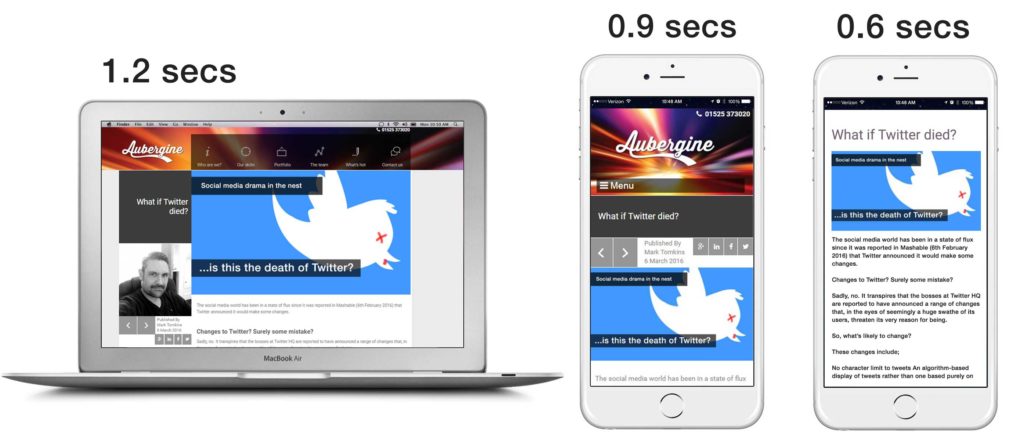AMP – Google’s Accelerated Mobile Page project
What is AMP?
AMP – Accelerated Mobile Pages, in a nutshell, is Google’s new project to help speed up use of the internet.
It is a new way to produce markup (web code) in the form of a stripped-down HTML version of each page of a website to display the bare bones – the text, some images and almost no functionality or styling.
Why is Google asking website owners and publishers to adopt this new, additional format as well as a mobile-optimised site? Reading the popular web press, some tech forums from those closest to Google’s inner circle (well, as close as one can ever be), the idea is to speed up the internet surfing experience where connectivity is low, such as third-world countries and high-demand traffic areas.
Aimed specifically at websites with news and blog sections, the AMP markup is designed to be for those who publish topical and news-based content. It’s not really aimed at a company website’s services or product pages but more their industry news and commentary pages. Obviously websites that are news and article-based will have the biggest changes to make but it’s possible that eventually (and if it takes off and works) may roll out to other types of page content.
We all know that a website’s page speed is hugely impactful on a website’s ability to rank well. If you have a slow, old and image-laden site with clunky code, it will take a long time to load and Google’s view on that is, quite simply, ‘try harder’ and will slowly penalise sites that take too long to load. You can check your website’s loading speed by using a free online tool, such as Pingdom to check this. As a very general rule, a desktop version of a website should not take any more than 1.5 seconds to load, less than 1 second is ideal. If it does, you need to look at the content (images and resources), the code and functionality to work out why – and then reduce it.
We ran one of our past blog articles against Pingdom (and held our breath)…

The results were surprising and provide tangible evidence for Google’s reasoning.
Within the last 5 years, we’ve moved towards having mobile optimised versions of websites. This is a slimmed-down version with a layout more appropriate for a small vertical touch screen with less content as users will be loading the site over 3G or 4G, rather than broadband or fibre. Happy days – we did that and it all worked out fine.
Now there’s a drive from Google to speed things up even more. Why?
Well, if we’re being a little cynical, we must assume it has to do with advertising revenue – what else could it be? Google has shown its colours recently with moving towards a much more paid-for search landscape by increasing the visible area of a search results page with more paid-for slots. As a result, this has pushed down the old ‘natural’ listing results to almost below the fold (below the browser bar and into digital oblivion).
The Google Ads machine works very well on desktops, mobile and tablets, too. But there’s a school of thought that says that because quite a lot of the world is still on low connectivity, Google are missing out on advertising revenue. So, by providing a skinny version of the internet, along with the ads, its reach can widen even more and generate larger income from areas that are currently languishing.
Other tech viewpoints include AMP’s introduction to:
- assist in the increase of smart phone sales
- reduce the spread of viruses by cutting out the reliance on javascript functionality (which is known for being vulnerable to viruses although the new framework includes a new AMP js toolset of reduced-functionality)…along with a thousand other conspiracy theories.
In the end, delivering a sped-up version of the internet on your mobile device is a good thing. The very nature of a user looking at the internet on their mobile device infers they are on-the-move and want information quickly – and this delivers on that brief.
This is all supported by Google’s AMP Cache – a global CDN (Content Delivery Network) that caches all the AMP versions and is able to deliver them at lightening speeds compared to traditional and mobile page versions.
How will browsers know when to deliver the AMP version?
A good question and one that we’re still investigating at the time of writing this article but we’re certain it has to do with page load speed. Once the AMP version of the page has been crawled and indexed, when you type in a web address, Google will time its load-speed to the browser and deliver the AMP version if there’s a whiff of slowness.
All this sounds reasonable but what are the downsides?
Downsides
A website’s domain authority will almost certainly suffer as the AMP version of a page will be cached in Google with a Google URL and so the website won’t benefit from a link to it’s actual domain.
Loss of style – we live in an image and branded-heavy world. Some brands and big names may choose to not adopt AMP at the cost of a negative impact on their brand image.
Overall advert impression numbers may go down as a result of the ads being displayed on the AMP page which is not currently trackable, as opposed to the normal desktop or mobile version of a page – which is trackable in Google Analytics.
Forms are not currently supported – so, no-dice for anything remotely e-commerce.
Summary
The idea is a good one – it’s speeding up the internet and its use thereof. It’s making website owners think about what’s really important on a page and trimming it down to the core data. So, less fluff and more action seems to be the new world order.

